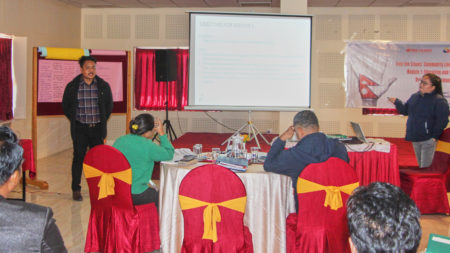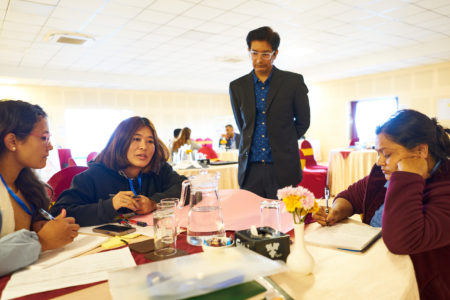Training Organizations to Mobilize Communities in Nepal
Free the Slaves' South Asia team, in collaboration with Read Nepal, organized an in-person Community Liberation Training for Civil Society Organizations and NGOs of Nepal. Fifteen organizations working on the issue of human trafficking and modern slavery participated in the training. The participants were from the following organizations:
- Swatantrata Abhiyan,
- Shanti Foundation,
- People Forum,
- Jahada Community Library and Resource Centers,
- Purple foundation,
- READ Nepal,
- Shreejana Community Library and Resource Center,
- Pourakhi Nepal,
- Sunita Foundation,
- Chhahari Nepal,
- Gyanbikash Community Library and Resource Center,
- Chhori/ATWWIN,
- Shakti Samuha.

Photo Courtesy of Read Nepal
The training was co-facilitated by Kuldeep Singh Chauhan, Regional Director, Asia and Tsering Diskit, Program Officer, Asia. The 3-day training was divided into 12 sessions, four sessions each day, and the participants received training on:
- The Definitions and History of Human Trafficking,
- Human Rights,
- Gender and Human Trafficking,
- Indicators of Human Trafficking and Response,
- The Community Liberation Model
- Community Mobilization
- And Impact Tracking.
Module 1, Educating and Mobilizing Vulnerable Communities, aims to support and equip communities to recognize vulnerabilities that lead to an increased risk of being trafficked. They learn about their rights and how to assert them to mitigate risk. Through collaborative participation, they work together to map resources available to vulnerable communities. At the conclusion of the training, they are equipped to work with local stakeholders to implement protective behaviors, build coalitions, and advocate for themselves.
The participants also learned the Free the Slaves' approach to educating and mobilizing vulnerable communities, a pillar of the FTS Community Based Liberation Model, and how it can be used to incorporate anti-slavery interventions into participating organizations' existing work. Participants also develop the ability to articulate the impact of slavery on the communities where they work and use that information to create a specific action plan to integrate community-based programming into their organization's work.
The training also gave space for participants to share their experiences in human trafficking and modern slavery. A few of the experiences shared are as follows –

Photo Credit: Bryon Lippincott
One participant shared their experiences related to organ trafficking, where a survivor they knew was working as a brink maker after he ran away from his home. A person who would become one of his traffickers convinced him to work as a driver. The trafficker told him that he needed to do blood checkups and asked for a blood sample. He wasn't aware, but his kidney was harvested during the procedure he thought was a blood test. After his kidney was taken, the victim was said to be given a cellphone worth 50000 rupees and 100,000 rupees. Thankfully the police intervened, a case was filed, and the case is still being prosecuted in court.”
Another participant also shared the experience of a rescue from the entertainment industry where reprogramming was done at the National level.
“As a rescuer, they (survivors) see us as an enemy for them. Many minors were rescued from the entertainment industry, but they were fine with working there, as they had some source of income and could earn their own living. Survivors who were participants in our program thought there should be a need for community-based modules. Traffickers were caregivers, but we, as an organization, were unable to provide anything to their families. They asked us, ‘We get food, shelter, and education, but what about our families?' So in one participant's view, there are problems with the approaches that we are doing.”
The effectiveness of the training was also evaluated using pre and post-training knowledge tests. The results reflected that 100% of the participants have increased their knowledge after the training. During the feedback session, the participants shared that they found the material, content, exercises, and facilitation techniques very helpful.
Swatantrata Abhiyan, Senior Program Officer at Manu Nepal, shared, “I really enjoyed the community mobilization toolkit session. It helped me to have a better understanding of the process of identifying effective strategies to minimize the risk of slavery in the community. Swatantrata Abhiyan Nepal is applying an Area Based Approach to make 30 municipalities in 3 provinces (Bagmati, Lumbini & Sudurpaschim) child-labor-free. So, I can relate the above-mentioned tools or techniques when implementing the project and dealing with municipalities.”
Sindhu Aryal from Pourakhi Nepal also shared, “Throughout the training, we got the chance to know about the community mobilization tools step by step, starting from the fundamental rights, identifying the survivors of modern slavery, and the evaluation measures.”
Kranti Tamang from Shanti Foundation shared, “Through the training, I learned the detailed community mobilization process and indicators of slavery. It also provided a platform for networking to enable a coordinated response. Thanks to the organizers and facilitators for organizing such an informative and engaging training.”
This “Eyes on Trafficking” story is reprinted from its original online location.
Fair Use Notice: The PBJ Learning Knowledge Vault is dedicated to advancing understanding of various social justice issues, including human trafficking and related topics. Some of the material presented on this website may contain copyrighted material, the use of which has not always been specifically authorized by the copyright owner. We are making such material available in our efforts to promote education and awareness of these important issues. There is no other central database we are aware of, so we put this together for both historical and research purposes. Articles are categorized and tagged for ease of use. We believe that this constitutes a ‘fair use' of any such copyrighted material as provided for in section 107 of the US Copyright Law. In accordance with Title 17 U.S.C. Section 107, the material on this site is distributed without profit to those who have expressed a prior interest in receiving the included information for research and educational purposes. For more information on fair use, please visit: “17 U.S. Code § 107 – Limitations on exclusive rights” on Cornell Law School's Legal Information Institute.
 ABOUT PBJ LEARNING
ABOUT PBJ LEARNING
PBJ Learning is a leading provider of online human trafficking training, focusing on awareness and prevention education. Their interactive Human Trafficking Essentials online course is used worldwide to educate professionals and individuals how to recognize human trafficking and how to respond to potential victims. Learn on any web browser (even your mobile phone) at any time.
More stories like this can be found in your PBJ Learning Knowledge Vault.
EYES ON TRAFFICKING
This “Eyes on Trafficking” story is reprinted from its original online location.
ABOUT PBJ LEARNING
PBJ Learning is a leading provider of online human trafficking training, focusing on awareness and prevention education. Their interactive Human Trafficking Essentials online course is used worldwide to educate professionals and individuals how to recognize human trafficking and how to respond to potential victims. Learn on any web browser (even your mobile phone) at any time.
More stories like this can be found in your PBJ Learning Knowledge Vault.
